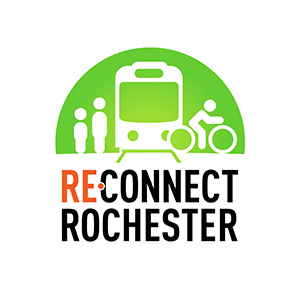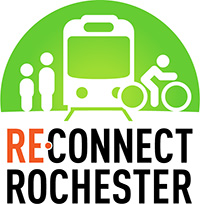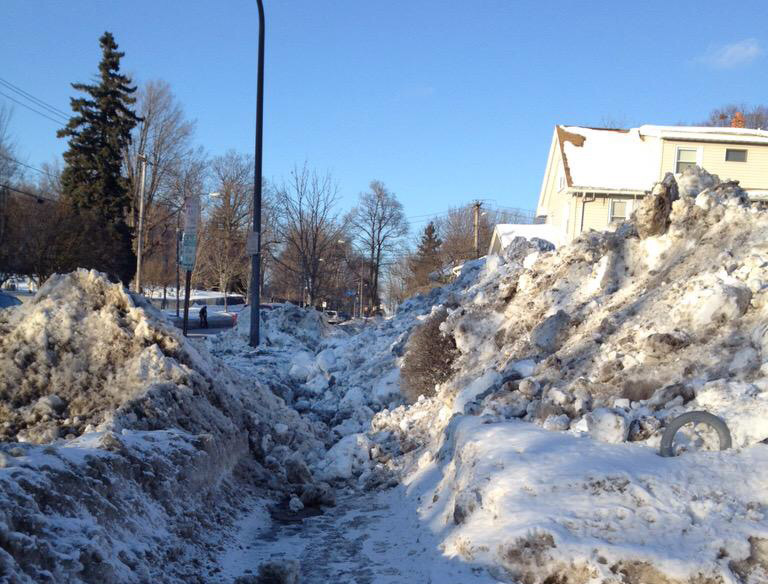Car Lite Rochester is a blog series that highlights the stories of Rochesterians living a car-lite lifestyle. The term “car lite” encompasses a variety of multimodal transportation lifestyles, featuring little dependence (but not NO dependence) on a car. It typically looks like sharing one car within a household or only using a car when absolutely necessary.
So, we hope you’ll continue to follow along. Maybe you will be inspired to join our bloggers in living a car-lite lifestyle!
Wanna rep it? Check out the t-shirt in our online shop.
My Journey to a Car-Lite Life in Rochester
By Jasmine Burley:
What do you mean, you don’t have a car?!
That’s usually the reaction I get when I tell people I try to rely on public transit and carpooling as much as possible in Rochester. It’s as if I just announced I forage for food in my backyard. But my journey to going car-lite wasn’t exactly straightforward. Let me explain.

Last October, I decided to take a trip to Washington, D.C. (before the political madness of 2024 took over). After attending Reconnect Rochester’s Street Films: The Sprawl Effect program, I was determined to make this trip extra memorable by reducing my carbon footprint as possible, so I set a challenge for myself: no cars, no Ubers—just my feet, the Metro, and the occasional bus. I had no idea if my body could handle it. I also had no idea this little experiment would completely change how I look at transportation back home in Rochester.
Because, let’s be honest—Rochester isn’t exactly known for its public transit. And yet, after years of feeling chained to my car, I started wondering: Could I make a car-lite life work here?
Growing Up Car-Lite
Though I was born in Rochester, I spent most of my childhood and teenage years in Tacoma, Washington (state, not D.C.), just south of Seattle. And let me tell you—public transportation there is incredible. Buses ran on predictable schedules and connected not just from suburbs to the city, but between suburbs, too. There’s a light rail system downtown that’s completely free to use and is currently being expanded across cities. Most kids walked or biked to school, and school buses picked up kids in groups rather than stopping at every individual house (I think of this often when I’m stuck behind a school bus in traffic). There weren’t lines of cars idling in front of schools like some kind of chaotic drive-thru. Carpooling was second nature. There were trains that took you north to Seattle and beyond or south to Oregon, even down to California. Recycling and composting were the norm. Community and sustainability were built into daily life.
Then in 2013, I moved back to Rochester, and…well. Let’s just say it was an adjustment. Public transportation here felt like an afterthought. When I mentioned the possibility of taking a bus, I got blank stares, or worse, concerned looks.
“It’s not safe.”
“What do you mean, you don’t have a car?!”
It was disheartening, to say the least. But I did what many do here—I got a car. I didn’t have a choice. A 15-minute drive to work would’ve been an hour-long bus ride. And so, like most Rochesterians, I became car-dependent.
My Health Forced a Change
In 2019, life threw me a curveball. I developed a rare autoimmune disease that left me completely paralyzed. Months of therapy helped me relearn how to walk, use silverware, drink out of a cup, even just see straight ahead in front of me. My body was fragile, and at the time, my focus was purely on survival: get to work, pay the bills, and come home.
I wasn’t thinking about how I got to and from places—I was just grateful to be able to go at all. I was given a second chance at life and I wasn’t about to take it for granted. My energy is now limited, so I kissed the opportunity to try to take the bus or walk to work goodbye.
A 15-minute drive to work would’ve been an hour-long bus ride. And so, like most Rochesterians, I became car-dependent.
Testing a Car-Free Life in Washington (D.C. this time)
Fast-forward to 2024. I changed career paths and met Chaz Goodman, who is now the Marketing & Outreach Manager at Reconnect Rochester. He invited me to come to their event “Street Films: The Sprawl Effect”. I was excited to hear how Rochester could be more sustainable with their transportation, so I went with my mother (we carpooled!) and I left feeling ambitious that it could be possible to rely less on a vehicle.

While Rochester’s limited in options, it’s not impossible. I was leaving for a trip soon to Washington D.C., so I made a gameplan: Could I set a no-car challenge during my trip and only rely on public transportation? I was stronger, but still cautious about my limits. I wasn’t sure if my disabled body could handle it. I would be kidding myself if I wasn’t worried.
Walking 20,000 steps a day? It sounded impossible; it was a huge leap from my usual 5,000. But with breaks, I made it work.
And the best part? I felt free.
I wasn’t stressed about parking. I wasn’t sitting in hours-long traffic just to get downtown. I wasn’t paying for gas. I was just…moving. Exploring. Seeing the city in a way you simply can’t from behind a windshield. So, I thought: What if I tried this at home?
The Rochester Experiment
When I got home, I made a goal: To take the bus to work. To put things in perspective, I live in North Greece, and I commute to downtown Rochester for work. I pulled up Google Maps and did some research. I found a possible solution: If I can be dropped off to a bus stop 10 minutes
from home, hop on the bus, and walk 10 minutes to work after I got off, it could be doable.
It sounded reasonable. My husband’s car lease was ending, so we were already considering downsizing to one car. This could actually work.
For about 2 solid months, I strictly relied on taking the bus to and from work. Sure, it took a little longer than it would have if I drove (35 minutes instead of 20), but I didn’t mind.

Pros
- The morning commute was a breeze. The bus was on time (a minor miracle in public transit).
- The extra time it took gave me more free time to read. I listened to music. I looked out the window and actually noticed the neighborhoods I was passing through. Rochester’s really beautiful!
- I never felt unsafe. In fact, I felt completely comfortable and felt as if I’ve done this route my whole life.
- The ride was comfortable and the people were pleasant.
- It was only $1 to ride the bus. UM, HELLO?! That’s way better than filling up a tank of gas 2-3x a month and paying a few hundred dollars a month towards a car payment.
- The 10–15-minute walk to work? Surprisingly lovely. Fresh air, a little movement—it was an easy way to get steps in without even thinking about it.
- The RTS Transit Center downtown? Super clean and well-designed—it felt like I was in a mini airport. (To put it in perspective, the transit centers back in Washington state were all outdoor, so I wasn’t used to this.)

Every Pros list has a cons list, so here are some of my not-so-favorite things about Rochester’s public transit:
Cons
- The evening commute? A whole different story. The Transit Center was chaotic. I got lost trying to find my bus a few times, and by the time I spotted it, I had to sprint to catch it (not exactly ideal for someone with mobility concerns.)
- The bus was PACKED in the evenings. Unlike the mornings, it was almost difficult for me to find a spot, and sometimes I was close to having to stand the whole way home.
- The stops felt endless. A 35-minute morning commute turned into 50+ minutes going home.
- The biggest issue? Frequency. But what would we expect differently if the bus only comes every 30 minutes? If it ran every 15 minutes, it would’ve been a game-changer. There’d be less people as we’d be spread out more.
- I recognize my blessings in having the ability to be dropped off at my bus stop, which is about a 10-minute drive from my house. What if I didn’t have that option? Then, I’d have to walk to my stop, which could take hours given my disabled body. That’s not feasible.
Where I Landed: A Car-Lite Life
I did my bus experiment for about 2 months before my body started to push back. The morning ride was fine, but running through downtown and the Transit Center in the evening and scrambling for a seat? Not sustainable as much for someone like me.
But in the end, this experiment had a lasting impact—My family officially downsized to one car. Now, my husband and I carpool to work. Some weeks, I drive just one day to work. I’m still car- lite—just in a different way. And I still take the bus here and there, but I make sure to give myself enough lead-time to catch the evening bus so I’m not running to catch it.
And honestly? It feels great. I spend WAY less on gas. I walk more than I used to. I feel more connected to my city. And I still dream of the day that Rochester invests in public transit the way Tacoma, Seattle, and D.C. have. Until then, I’ll keep doing what I can—one less car ride at a time.
At Reconnect, we’re inspired by the stories of people in our community, like Karen Nozik, Steve Roll, and Calvin Eaton, who are passionate about living a car-lite or car-free lifestyle. If you want to support our work and make it easier for others to go Car-Lite please donate and sign up for Mobility Action Alerts to stay in the loop with opportunities of how to advocate for safer streets and transportation options.
Let us know if you want to share your mobility story! What’s in it for you? The intrinsic reward of knowing you’ve inspired others, and a free t-shirt from our online shop! Contact Chaz to submit your story.





















![Sidewalk off Mt. Hope [Photo: Brenda Massie]](http://www.reconnectrochester.org/images/photos/snow-sidewalk-rochester-ny-01.jpg)